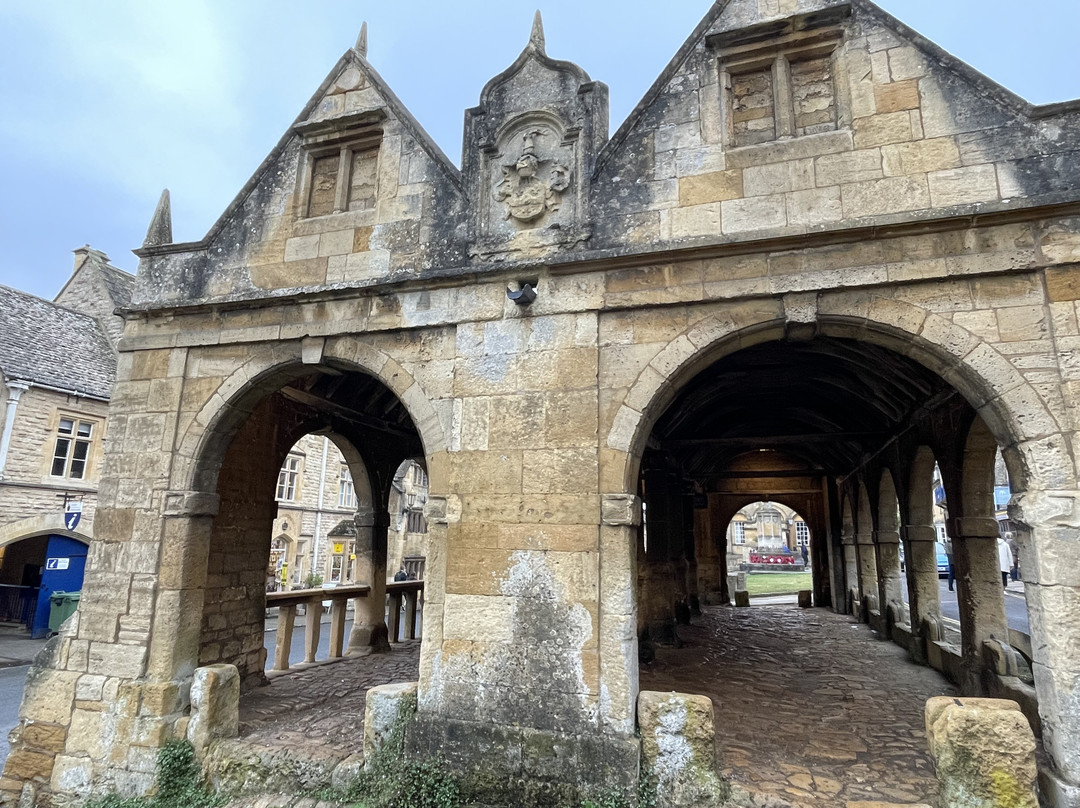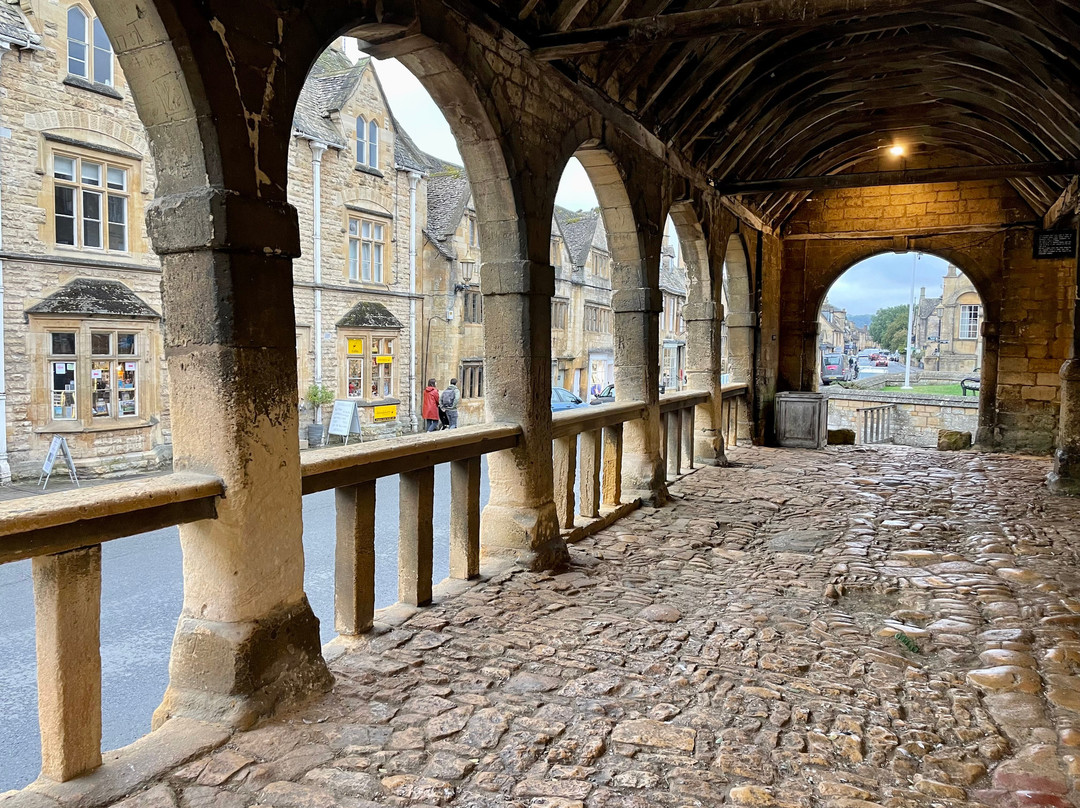的点评
Chipping Campden's Most Famous Landmark
Market Hall的点评
点评:The Market Hall is the most famous landmark in Chipping Campden. As we walked down the High Street, its honey-coloured Cotswold limestone arches and gabled roofline caught our eye immediately .
Built in 1627, by Sir Baptist Hicks, Lord of Chipping Campden Manor, it is incredibly well-preserved. If you walk inside and tip your head back to look straight up to the roof, the timbers look exactly like they would have done 400 years ago. When we looked carefully, we could see the wooden pegs that hold the stone shingles in place. At your feet, the the ancient cobbled stone pavers form the original floor. You can see the marks of centuries of wear. Many areas are worn smooth.
The side walls are not solid and are open arches which makes sense when you think of how it was used. Customers could come and go and had easy access to the stalls.
Back in the day, it was a thriving centre of commerce and would have been bustling with traders selling trade local produce and goods like cheese, bread, butter and poultry.
Although Chipping Campden was a very prosperous sheep and wool town, wool was never sold at this market.
Hicks was a generous benefactor to the town. In addition to the market hall, he built almshouses for the poor and made significant donations to the church.
He had made his fortune as a trader in silks, satins and fine fabrics and, more importantly, as a money-lender to King James I. The Hicks’ family coat of arms can be seen on the facade of the hall, between the two gables on the opposite side to the war memorial.
Built in 1627, by Sir Baptist Hicks, Lord of Chipping Campden Manor, it is incredibly well-preserved. If you walk inside and tip your head back to look straight up to the roof, the timbers look exactly like they would have done 400 years ago. When we looked carefully, we could see the wooden pegs that hold the stone shingles in place. At your feet, the the ancient cobbled stone pavers form the original floor. You can see the marks of centuries of wear. Many areas are worn smooth.
The side walls are not solid and are open arches which makes sense when you think of how it was used. Customers could come and go and had easy access to the stalls.
Back in the day, it was a thriving centre of commerce and would have been bustling with traders selling trade local produce and goods like cheese, bread, butter and poultry.
Although Chipping Campden was a very prosperous sheep and wool town, wool was never sold at this market.
Hicks was a generous benefactor to the town. In addition to the market hall, he built almshouses for the poor and made significant donations to the church.
He had made his fortune as a trader in silks, satins and fine fabrics and, more importantly, as a money-lender to King James I. The Hicks’ family coat of arms can be seen on the facade of the hall, between the two gables on the opposite side to the war memorial.
翻译:市场大厅是奇平卡姆登最著名的地标。我们沿着高街漫步,蜂蜜色的科茨沃尔德石灰岩拱门和人字形屋顶立刻吸引了我们的目光。
市场大厅由奇平卡姆登庄园领主巴普蒂斯特·希克斯爵士于1627年建造,保存完好。走进大厅,仰头直视屋顶,木材的模样与400年前一模一样。仔细观察,我们能看到固定石瓦的木桩。脚下,古老的鹅卵石铺砌成了最初的地面。你可以看到几个世纪以来的磨损痕迹。许多地方都被磨得光滑。
侧墙并非实心,而是开放式拱门,考虑到它过去的用途,这也很合理。顾客可以自由进出,轻松进出摊位。
昔日,这里曾是繁荣的商业中心,商贩们熙熙攘攘,贩卖着当地农产品以及奶酪、面包、黄油和家禽等商品。
尽管奇平卡姆登曾是一座繁荣的绵羊和羊毛小镇,但这个市场从未出售过羊毛。
希克斯对这座小镇慷慨解囊。除了市场大厅,他还为穷人建造了救济院,并向教会捐赠了巨额款项。
他通过经营丝绸、缎子和精美织物积累了财富,更重要的是,他曾为詹姆斯一世国王放债。希克斯家族的盾徽可以在大厅的正面看到,位于战争纪念碑对面的两座山墙之间。
市场大厅由奇平卡姆登庄园领主巴普蒂斯特·希克斯爵士于1627年建造,保存完好。走进大厅,仰头直视屋顶,木材的模样与400年前一模一样。仔细观察,我们能看到固定石瓦的木桩。脚下,古老的鹅卵石铺砌成了最初的地面。你可以看到几个世纪以来的磨损痕迹。许多地方都被磨得光滑。
侧墙并非实心,而是开放式拱门,考虑到它过去的用途,这也很合理。顾客可以自由进出,轻松进出摊位。
昔日,这里曾是繁荣的商业中心,商贩们熙熙攘攘,贩卖着当地农产品以及奶酪、面包、黄油和家禽等商品。
尽管奇平卡姆登曾是一座繁荣的绵羊和羊毛小镇,但这个市场从未出售过羊毛。
希克斯对这座小镇慷慨解囊。除了市场大厅,他还为穷人建造了救济院,并向教会捐赠了巨额款项。
他通过经营丝绸、缎子和精美织物积累了财富,更重要的是,他曾为詹姆斯一世国王放债。希克斯家族的盾徽可以在大厅的正面看到,位于战争纪念碑对面的两座山墙之间。



此点评仅代表旅行者个人的主观意见,并不代表TripAdvisor以及其合作方的意见。
关于我们
|
新闻动态
|
商务合作
|
会员中心
|
业主中心
|
业主通
|
常见问题
|
意见反馈
|
联系我们
|
营业执照
© 2025 Tripadvisor 版权所有。
使用条款 |隐私政策 |网站工作原理
部分照片由 VFM Leonardo 提供。
* Tripadvisor不是旅行社,也不是旅游预订服务代理商。我们提供免费、客观、公正的旅游资讯服务。 (显示更多)
TripAdvisor LLC 既不是预订代理商,也不是旅游运营商,不会向网站用户收取任何服务费。 按照规定,在 Tripadvisor 发布机票价格、游览和旅行套餐的合作伙伴(航空公司、旅行提供商及预订代理商),其标价须包含所有费用和附加费用。 例如, 机场出入境税费、消费税与其他服务费、手续费、杂费及附加费用。 当您向我们的某个合作伙伴进行预订时,请务必查阅他们的网站以了解当地行政部门要求的所有适用费用的具体情况。 除非另有说明,机票价格通常指的是一个人的价格(以人民币计)。
为方便起见,TripAdvisor LLC 根据从我们的预订合作伙伴获取的空房率计算每个酒店的均价。 对于游览和景点来说,所显示价格通常是每位成人的最低可用价格。 对于列出的任何旅行套餐或优惠,TripAdvisor LLC 无法保证任何特定的费率或价格。 此外,酒店均价每晚会更新,并以您的首选币种表示(使用现行汇率)。 由于这些已换算的价格是预估价格,因此,有关具体金额和币种请与预订网站进行核实。
此外,TripAdvisor LLC 无法保证我们网站上宣传的价格随时有效。 标价可能需要预订一定天数才能生效,或有不可用日期、使用条件或限制。
TripAdvisor公司对外部网站的内容一概不负责。优惠价格中不含税和其他费用。
ICP证:沪B2-20200433
沪ICP备20013175号
 沪公网安备31010502005427号
沪公网安备31010502005427号鹰程信息技术(上海)有限公司
货币/国家及地区
¥CNY
中国

